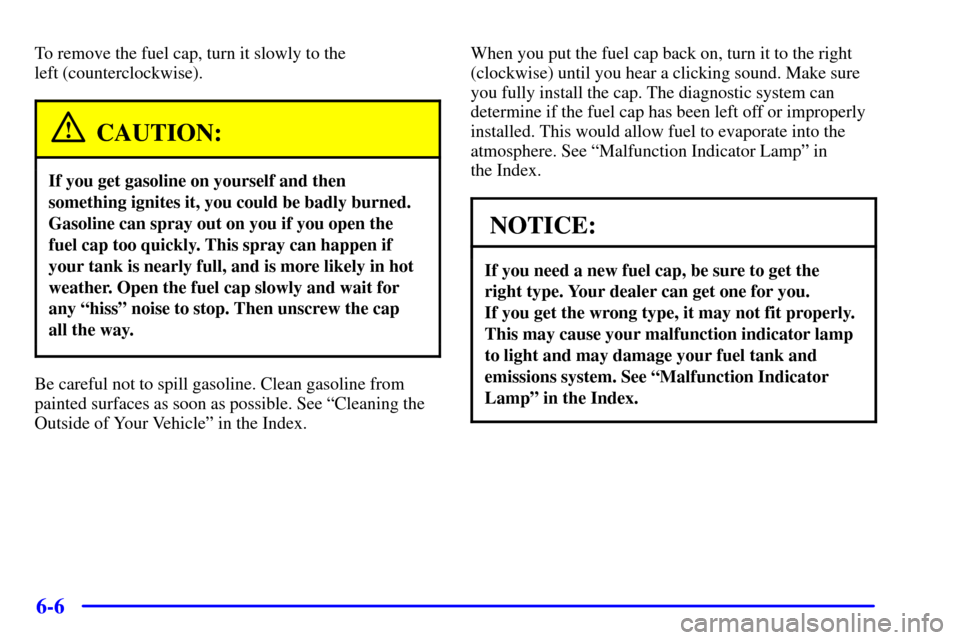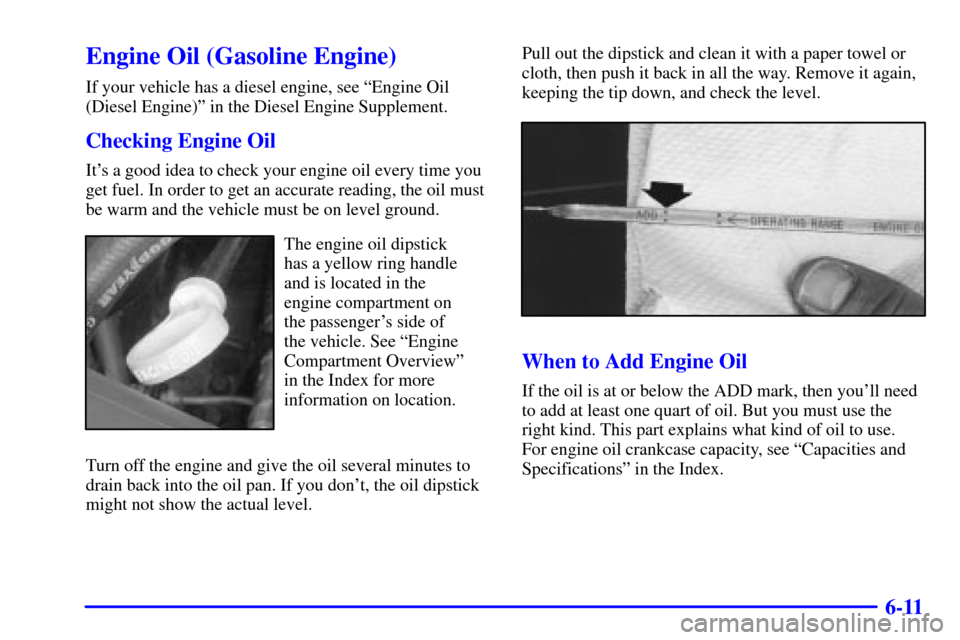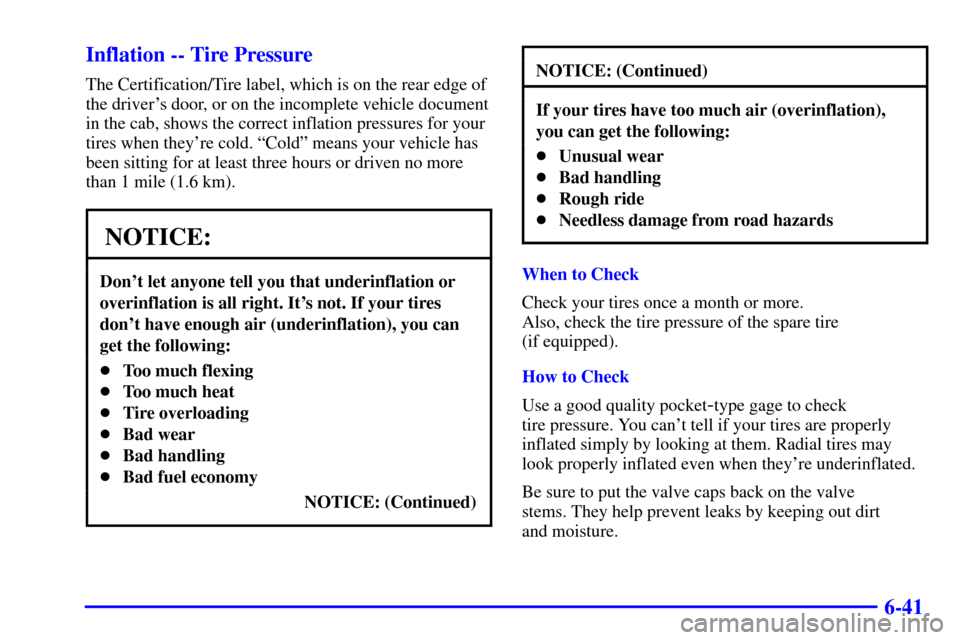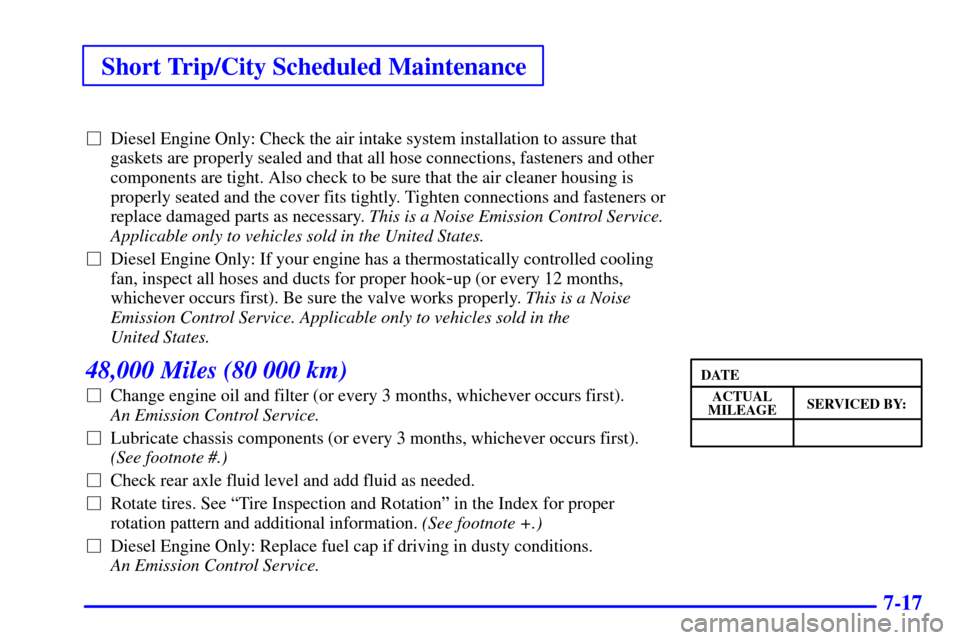Page 201 of 331

6-6
To remove the fuel cap, turn it slowly to the
left (counterclockwise).
CAUTION:
If you get gasoline on yourself and then
something ignites it, you could be badly burned.
Gasoline can spray out on you if you open the
fuel cap too quickly. This spray can happen if
your tank is nearly full, and is more likely in hot
weather. Open the fuel cap slowly and wait for
any ªhissº noise to stop. Then unscrew the cap
all the way.
Be careful not to spill gasoline. Clean gasoline from
painted surfaces as soon as possible. See ªCleaning the
Outside of Your Vehicleº in the Index.When you put the fuel cap back on, turn it to the right
(clockwise) until you hear a clicking sound. Make sure
you fully install the cap. The diagnostic system can
determine if the fuel cap has been left off or improperly
installed. This would allow fuel to evaporate into the
atmosphere. See ªMalfunction Indicator Lampº in
the Index.
NOTICE:
If you need a new fuel cap, be sure to get the
right type. Your dealer can get one for you.
If you get the wrong type, it may not fit properly.
This may cause your malfunction indicator lamp
to light and may damage your fuel tank and
emissions system. See ªMalfunction Indicator
Lampº in the Index.
Page 206 of 331

6-11
Engine Oil (Gasoline Engine)
If your vehicle has a diesel engine, see ªEngine Oil
(Diesel Engine)º in the Diesel Engine Supplement.
Checking Engine Oil
It's a good idea to check your engine oil every time you
get fuel. In order to get an accurate reading, the oil must
be warm and the vehicle must be on level ground.
The engine oil dipstick
has a yellow ring handle
and is located in the
engine compartment on
the passenger's side of
the vehicle. See ªEngine
Compartment Overviewº
in the Index for more
information on location.
Turn off the engine and give the oil several minutes to
drain back into the oil pan. If you don't, the oil dipstick
might not show the actual level.Pull out the dipstick and clean it with a paper towel or
cloth, then push it back in all the way. Remove it again,
keeping the tip down, and check the level.
When to Add Engine Oil
If the oil is at or below the ADD mark, then you'll need
to add at least one quart of oil. But you must use the
right kind. This part explains what kind of oil to use.
For engine oil crankcase capacity, see ªCapacities and
Specificationsº in the Index.
Page 236 of 331

6-41 Inflation -- Tire Pressure
The Certification/Tire label, which is on the rear edge of
the driver's door, or on the incomplete vehicle document
in the cab, shows the correct inflation pressures for your
tires when they're cold. ªColdº means your vehicle has
been sitting for at least three hours or driven no more
than 1 mile (1.6 km).
NOTICE:
Don't let anyone tell you that underinflation or
overinflation is all right. It's not. If your tires
don't have enough air (underinflation), you can
get the following:
�Too much flexing
�Too much heat
�Tire overloading
�Bad wear
�Bad handling
�Bad fuel economy
NOTICE: (Continued)
NOTICE: (Continued)
If your tires have too much air (overinflation),
you can get the following:
�Unusual wear
�Bad handling
�Rough ride
�Needless damage from road hazards
When to Check
Check your tires once a month or more.
Also, check the tire pressure of the spare tire
(if equipped).
How to Check
Use a good quality pocket
-type gage to check
tire pressure. You can't tell if your tires are properly
inflated simply by looking at them. Radial tires may
look properly inflated even when they're underinflated.
Be sure to put the valve caps back on the valve
stems. They help prevent leaks by keeping out dirt
and moisture.
Page 262 of 331
6-67 Capacities
After refill, the level must be rechecked. See ªCooling
Systemº in the Index.
Engine VIN Quantity
ªVORTECº 8100 G 28.5 quarts (27.0 L)
Engine Oil with Filter
After refill, the level must be rechecked. Add enough
engine oil so that the fluid is within the proper operating
range. See ªEngine Oilº in the Index.
Engine VIN Quantity
ªVORTECº 8100 G 6.6 quarts (6.3 L)
Fuel Tank Capacity
Type Quantity
Front Tank 22.0 U.S. gallons (79 L)
Rear Tank 18.0 U.S. gallons (68 L)
Air Conditioning
Refrigerant Capacity
If you do your own service work, you'll need the proper
service manual. See ªDoing Your Own Service Workº in
the Index for additional information. It is recommended
that service work on your air conditioning system be
performed by a qualified technician.
Air Conditioning
Refrigerant R
-134a 2.0 lbs (0.91kg). . . . . . . . . . . . .
Use Refrigerant Oil, R134a Systems
Page 263 of 331

6-68
Normal Maintenance
Replacement Parts
Replacement part numbers listed in this section are
based on the latest information available at the time of
printing, and are subject to change. If a part listed in
this manual is not the same as the part used in your
vehicle when it was built, or if you have any questions,
please contact your GM truck dealer.
These specifications are for information only. If you
have any questions, see the service manual for the
chassis or refer to the body manufacturer's publications.VIN Code G. . . . . . . . . . . . . . . . . . . . . . . . . . . .
Oil Filter* PF454. . . . . . . . . . . . . . . . . . . . . . . .
Engine Air Cleaner Filter* A1300C�� . . . . . . . .
Spark Plugs*** TJ14R-P15 . . . . . . . . . . . . . . .
Fuel Filter* GF626. . . . . . . . . . . . . . . . . . . . . . .
Wiper Blades** 22154886. . . . . . . . . . . . . . . . .
Wiper Blade Type Trico. . . . . . . . . . . . . . . . . .
Wiper Blade Length 18 inches (45.0 cm). . . . . .
*ACDelco
� part number
**GM part number
***Denso part number
��A1301C high
-capacity air cleaner filter.
Page 268 of 331

Scheduled Maintenance
7-5
Short Trip/City Definition
Follow the Short Trip/City Scheduled Maintenance if
any one of these conditions is true for your vehicle:
�Most trips are less than 5 miles (8 km). This is
particularly important when outside temperatures
are below freezing.
�Most trips include extensive idling (such as frequent
driving in stop
-and-go traffic).
�You frequently tow a trailer.
�If the vehicle is used for delivery service, police, taxi
or other commercial application.
One of the reasons you should follow this schedule if
you operate your vehicle under any of these conditions
is that these conditions cause engine oil to break
down sooner.
Short Trip/City Intervals
Every 3,000 Miles (5 000 km): Engine Oil and Filter
Change (or 3 months, whichever occurs first). Chassis
Lubrication (or 3 months, whichever occurs first).
Rear Axle Fluid Check.
Every 6,000 Miles (10 000 km): Tire Rotation.
Every 15,000 Miles (25 000 km): Shields and
Underhood Insulation Inspection. Diesel Engine
Only: Thermostatically Controlled Engine Cooling
Fan Check (or every 12 months, whichever occurs
first). Diesel Engine Only: Air Intake System
Inspection. Front Wheel Bearing Repack (or at each
brake relining, whichever occurs first).
Every 24,000 Miles (40 000 km): Diesel Engine Only:
Fuel Cap Replacement, if driving in dusty conditions.
Every 30,000 Miles (50 000 km): Rear Axle Fluid
Change with Extreme Overload, Trailer Towing or
High Speed Use. Fuel Filter Replacement.
(Continued)
Page 275 of 331
Short Trip/City Scheduled Maintenance
7-12
21,000 Miles (35 000 km)
�Change engine oil and filter (or every 3 months, whichever occurs first).
An Emission Control Service.
�Lubricate chassis components (or every 3 months, whichever occurs first).
(See footnote #.)
�Check rear axle fluid level and add fluid as needed.
24,000 Miles (40 000 km)
�Change engine oil and filter (or every 3 months, whichever occurs first).
An Emission Control Service.
�Lubricate chassis components (or every 3 months, whichever occurs first).
(See footnote #.)
�Check rear axle fluid level and add fluid as needed.
�Rotate tires. See ªTire Inspection and Rotationº in the Index for proper
rotation pattern and additional information. (See footnote +.)
�Diesel Engine Only: Replace fuel cap if driving in dusty conditions.
An Emission Control Service.
ACTUAL
SERVICED BY:MILEAGE
DATE
ACTUAL
SERVICED BY:MILEAGE
DATE
Page 280 of 331

Short Trip/City Scheduled Maintenance
7-17
�Diesel Engine Only: Check the air intake system installation to assure that
gaskets are properly sealed and that all hose connections, fasteners and other
components are tight. Also check to be sure that the air cleaner housing is
properly seated and the cover fits tightly. Tighten connections and fasteners or
replace damaged parts as necessary. This is a Noise Emission Control Service.
Applicable only to vehicles sold in the United States.
�Diesel Engine Only: If your engine has a thermostatically controlled cooling
fan, inspect all hoses and ducts for proper hook
-up (or every 12 months,
whichever occurs first). Be sure the valve works properly. This is a Noise
Emission Control Service. Applicable only to vehicles sold in the
United States.
48,000 Miles (80 000 km)
�Change engine oil and filter (or every 3 months, whichever occurs first).
An Emission Control Service.
�Lubricate chassis components (or every 3 months, whichever occurs first).
(See footnote #.)
�Check rear axle fluid level and add fluid as needed.
�Rotate tires. See ªTire Inspection and Rotationº in the Index for proper
rotation pattern and additional information. (See footnote +.)
�Diesel Engine Only: Replace fuel cap if driving in dusty conditions.
An Emission Control Service.ACTUAL
SERVICED BY:MILEAGE
DATE